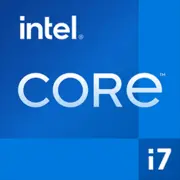Intel Core i7-10700KF

Intel Core i7-10700KF: Complete Review and PC Build Recommendations
Guide for Gamers, Enthusiasts, and Professionals
1. Key Specifications: Power on 14 nm
The Intel Core i7-10700KF processor, introduced in 2020, is part of the Comet Lake-S lineup. Despite utilizing the "outdated" 14nm manufacturing process, it showcases impressive performance thanks to architecture optimizations.
Architecture and Cores
- 8 cores, 16 threads thanks to Hyper-Threading.
- Base frequency: 3.8 GHz, maximum in Turbo Boost: 5.1 GHz (single core).
- 16 MB of L3 cache — sufficient for fast data processing in gaming and work tasks.
Manufacturing Process and TDP
- 14nm (Intel was unable to transition to 10nm in the desktop segment), TDP — 125W.
- Unlocked multiplier (designated "K") — overclocking is possible but requires good cooling.
Performance
- Geekbench 6: 1695 (single-thread), 8138 (multi-thread).
- In gaming (e.g., Cyberpunk 2077), it matches the FPS of Ryzen 7 3700X, but with a slight edge due to high frequency.
Key Features
- Support for Intel Thermal Velocity Boost for automatic frequency increase at lower temperatures.
- No integrated graphics (designated "F"), which lowers costs but requires a discrete graphics card.
2. Compatible Motherboards: Choose Wisely
The processor uses the LGA 1200 socket, which is only compatible with 400-series chipsets:
- Z490 — the best choice for enthusiasts:
- Support for CPU and memory overclocking.
- PCIe 3.0 (but some boards offer PCIe 4.0 for future upgrades, such as the ASUS ROG Maximus XII Extreme).
- B460/H470 — for those who do not plan to overclock:
- RAM frequency limit (up to 2933 MHz for B460).
- H410 — budget option for office PCs (not recommended for i7-10700KF due to weak VRM).
Tip: If you want to unleash the potential of the 10700KF, choose a Z490 board with a powerful power delivery system (e.g., MSI MPG Z490 Gaming Edge WiFi).
3. Memory: DDR4 and Dual Channel Mode
The processor supports DDR4 with a maximum frequency of:
- 2933 MHz on B460/H470 chipsets.
- Above 4000 MHz when overclocked on Z490.
Recommendations:
- For gaming: 16 GB (2x8 GB) DDR4-3200 with CL16 timings (e.g., Kingston HyperX Fury).
- For rendering: 32 GB (2x16 GB) DDR4-3600.
Important: DDR5 is not supported — a drawback for those planning upgrades to new platforms.
4. Power Supply: Don't Skimp on Energy
With a TDP of 125W and overclocking, power consumption can reach 200W.
Recommendations:
- Minimum 650W for a system with an RTX 3070 level graphics card.
- Prefer power supplies with an 80+ Gold certification (e.g., Corsair RM650x).
- For top-tier GPUs (RTX 3080/3090) — 750-850W.
Common Mistake by Newbies: Using cheap PSUs with poor voltage stabilization leads to FPS drops and restarts under load.
5. Pros and Cons: Weighing the Arguments
Pros:
- High gaming performance.
- Overclocking potential.
- Stability in work applications (Adobe Premiere, Blender).
Cons:
- Heats up to 95°C under load (liquid cooling or a high-end cooler is necessary).
- No PCIe 4.0 (relevant for next-gen NVMe SSDs).
- Higher power consumption compared to Ryzen 5000 series.
6. Use Cases: Who is this CPU for?
- Gamers: Ideal for 1440p/4K paired with RTX 3080. In CS:GO and Valorant — 300+ FPS.
- Content creators: Rendering in DaVinci Resolve on 8 cores is about 20% faster than with the i5-10600K.
- Streamers: NVENC in graphics cards reduces CPU load, but 16 threads are sufficient for encoding in OBS.
Example from Practice: When building a streaming PC for Dota 2 with i7-10700KF and RTX 3060 Ti, users report no lags even at 1080p60 streaming.
7. Comparison with Competitors
- AMD Ryzen 7 3700X:
- Pros: PCIe 4.0, runs cooler.
- Cons: Lower frequency in games (~10% difference at Full HD).
- AMD Ryzen 7 5800X:
- Leader in single-thread performance, but more expensive.
- Intel Core i9-10900K:
- More powerful by 10–15%, but higher price and minimal gaming improvement.
Conclusion: i7-10700KF is a sweet spot between price and performance.
8. Practical Build Tips
1. Cooling:
- Minimum — a tower cooler with 200W TDP (Noctua NH-D15).
- Optimal — liquid cooling 240mm (NZXT Kraken X53).
2. Case: Choose models with good airflow (Lian Li Lancool II Mesh).
3. Memory: Activate XMP in BIOS to run at nominal frequency.
4. Overclocking: A voltage of up to 1.35V can achieve 5.0 GHz on all cores.
9. Final Conclusion: Who Should Choose the i7-10700KF?
Choose this processor if:
- You want a powerful gaming PC without overspending on top models.
- You need stability in work tasks, but PCIe 4.0 is not critical.
- You are willing to invest in quality cooling and a motherboard.
Alternative: If PCIe 4.0 and energy efficiency are priorities — consider the Ryzen 7 5800X.
The Intel Core i7-10700KF remains a relevant choice in 2023 for those seeking a balance between price and performance. The key is to select the right components for the system.
Basic
CPU Specifications
Memory Specifications
Miscellaneous
Benchmarks
Compared to Other CPU
Share in social media
Or Link To Us
<a href="https://cputronic.com/cpu/intel-core-i7-10700kf" target="_blank">Intel Core i7-10700KF</a>